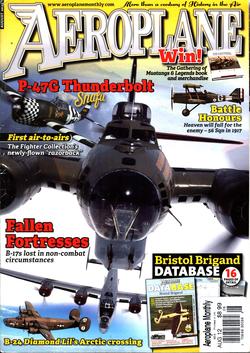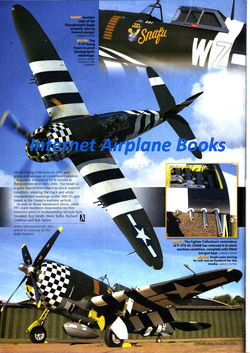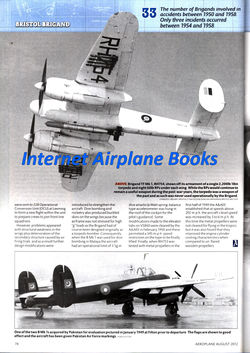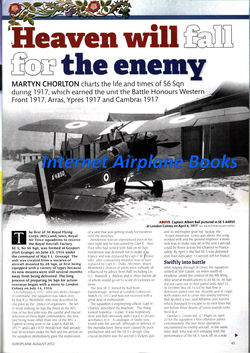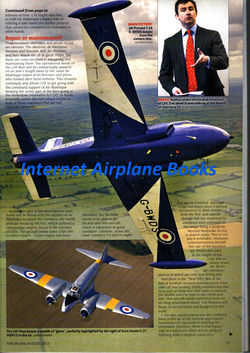AEROPLANE
AUG 12 RAF BRISTOL BRIGAND_B-17_B-24_BLOCH MB.220_P-47G_WW1 56 SQN S.E.5a
DATABASE: RAF BRISTOL BRIGAND (16
PAGES OF DETAILS)
BATTLE HONOURS WW1 RFC RAF No.56
SQN S.E.5a 1917
WW2 REPUBLIC P-47G THUNDERBOLT
FG USAAF
FALLEN FORTRESSES – WW2 BOEING B-17s
LOST UNDER NON-COMBAT CIRUMSTANCES
CONSOLIDATED B-24 LIBERATOR “DIAMOND
LIL” ARCTIC CROSSING
MIDLAND AIR MUSEUM
AIRLINER ARCHIVE – BLOCH MB.220
WW2 GERMAN LUFTWAFFE HEINKEL
He115 RECOVERED IN NORWAY
FHC WW2 IJN MITSUBISHI A6M ZERO
DEBUT
SWEDEN DE HAVILLAND VAMPIRE
DIAMOND JUBILEE FLYPAST
RAF DHC-1 CHIPMUNK BBMF
NORTH AMERICAN AVIATION A-36 APACHE
DIVE BOMBER USAAF PILOT
THE WORLD’S ONLY AIRWORTHY YAK-1
PROJECT
---------------------------------------------------------------------------------------------------------------------------------
Additional information from
Internet Encyclopedia
The Bristol Brigand was a
British anti-shipping/ground attack/dive bomber aircraft, developed by the
Bristol Aeroplane Company as a replacement for the Beaufighter. A total of 147
were built and were used by the Royal Air Force in Malaya during the Malayan
Emergency and Kenya until replaced by the de Havilland Hornet in Malaya and the
English Electric Canberra jet bomber elsewhere.
The Bristol Type 164 was the
outcome of the 1942 Air Ministry specification H.7/42 calling for a faster
edition of the Beaufighter for long-range torpedo work and anti-shipping
strikes.
The Bristol design team under
Leslie J. Frise, used the wings, tail and undercarriage of the Buckingham with
a new fuselage of oval cross-section. The pilot, navigator/bomb aimer and
radio-operator/gunner were grouped in the forward cockpit. In spite of the
official change in its role to a bomber, the first eleven Brigands off the
production line were completed as torpedo bombers. These early aircraft served
with the RAF Coastal Command from 1946–1947 before being converted to bombers.
The first unit to convert from
Beaufighters to the Brigand was 45 Squadron, based at RAF Station Tengah on the
Island of Singapore, operating in support of British forces against the
Communist Guerrillas, engaged in an insurgency in Malaya. The first Brigand was
flown to Tengah from RAF St Athan in November 1949, a 16-day trip. After test
flights, the first combat operation was conducted by the Brigand, piloted by
Flight Lieutenant Dalton Golding and crewed by radio/radar operator Peter
Weston, together with four Beaufighters of No. 45 Squadron against CT targets
in jungle west of Kluang, Malaya on 19 December 1949. The Brigand carried three
rockets, one 500 lb (230 kg) and two 1,000 lb (450 kg) bombs. The operation was
successful and No. 45 Squadron soon completed its conversion to the Brigand.
Brigands of 45 Squadron and soon
84 Squadron were routinely engaged in strikes against Communist Insurgent
targets throughout Malaya, direct and in close support of ground forces, as
well as providing air cover as needed to convoys on the ground, against
possible ambushes.
Problems with the Brigand became
apparent during its operations in Malaya, with undercarriages failing to lower.
This was traced to rubber seals in the hydraulic jacks deteriorating in the
hot, humid climate. Just as this problem was being resolved another problem
arose, more serious because it led to fatalities; a propensity for aircraft
damage and loss, during strafing runs employing the four 20 mm cannon. An
accumulation of gases in the long cannon blast tubes, which ran under the cockpit,
were igniting through use of high-explosive shells. This in turn severed
hydraulic lines, which would burn; the Brigands were shooting themselves down.
This was cured by drastically reducing the ammunition loads and using only ball
rounds. The Brigand also had a propensity to shed one propeller blade leading
to complete propeller failure, which in turn would lead to the engine being
wrenched off the wing and an inevitable crash. This was found to be caused by
corrosion in the propeller locking rings. More frequent maintenance helped
alleviate this problem. When everything was working properly the Brigand was
considered by its pilots to be a good aircraft to fly.
As the Brigand became hedged in
with more restrictions, both unit commanders had serious doubts about continued
use of the aircraft. It was decided to keep on operating them, as long as
thorough maintenance was carried out it was felt that nothing else could go
wrong. Another design flaw arose in the leather bellows used to deploy air
brake during dives. In the tropical climate, the leather would rot away,
causing the brakes to fail. This led to Brigands losing wings in dives due to
excessive airspeed or rotation as only one brake deployed. When this problem
was discovered, the air brakes of all Brigands were wired shut, decreasing the
aircraft's dive bombing capabilities. No. 45 Squadron converted to de Havilland
Hornets in January 1952 while 84 Squadron was disbanded in February 1953. Soon
after this, the Brigands were grounded and withdrawn from service.
Brigands were also used
operationally over Aden by 8 Squadron from 1950 to 1952, when it was found that
the Brigand mainspars were suspect; the Brigands were replaced by de Havilland
Vampires.
The first to be built was the
Brigand I or Brigand TF 1 and these entered service with RAF Coastal Command
No. 36 Squadron and No. 42 Squadron. They were subsequently rebuilt to become
the Brigand B 1, notable as both the first purpose-built multi-role bomber for
the RAF and its last piston-engined bomber. It could carry either a 22 in (560
mm) torpedo under the fuselage with two 500 lb (230 kg) bombs beneath the
wings, one 2,000 lb (910 kg) or two 1,000 lb (450 kg) bombs beneath the
fuselage and had under-wing racks for 16 RP-3 60 lb (30 kg) rocket projectiles.



